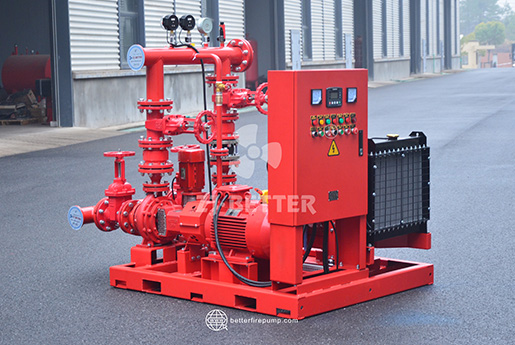In the world of fire protection, every component plays a vital role in ensuring safety and performance during an emergency. Among the technical aspects of fire pumps, the term "shutoff head" might not be well-known outside of engineering circles, but it plays a critical role in the efficiency, safety, and compliance of fire pump systems.
This article will explore what fire pump shutoff head is, why it matters in the design and operation of fire pump systems, and what professionals need to know when selecting and maintaining fire pumps in accordance with industry standards such as NFPA 20.

Shutoff head, also known as dead head or maximum head, is the maximum pressure a fire pump can produce at zero flow. In simpler terms, it’s the pressure generated by the pump when the discharge valve is completely closed and no water is moving through the system.
Think of it like revving a car engine in neutral — the engine is working, but the vehicle isn’t moving. In a similar way, when a fire pump runs against a closed valve, it builds up pressure, and this pressure is measured as the shutoff head.
It is typically measured in feet or meters of water (or sometimes PSI) and represented on a pump’s performance curve at the point where flow = 0.
Operating a fire pump at shutoff head for extended periods can lead to overheating and damage. Since no water is flowing to carry heat away, the pump casing and impeller can experience thermal stress, potentially leading to failure.
Also, excessive shutoff pressure may cause pipe ruptures or valve failures if the system components are not rated for such high pressures. This makes understanding and controlling shutoff head vital to system integrity and personnel safety.
According to NFPA 20 (Standard for the Installation of Stationary Pumps for Fire Protection), there are strict limits on the allowable shutoff head for fire pumps.
Section 4.8.2 of NFPA 20 states:
The maximum shutoff head (no-flow condition) shall not exceed 140% of the net head at rated flow for pumps with a rated speed of 3600 rpm or less, and 130% for pumps operating above 3600 rpm.
Why this limitation? Because higher-than-allowed shutoff heads could exceed the pressure rating of system components, leading to dangerous over-pressurization during startup or malfunction.
Failing to meet these requirements can result in code violations, project delays, or even rejection during system inspections.
When engineers select fire pumps for a project, they consider the total head required, including friction loss, elevation differences, and system pressure requirements. Shutoff head becomes part of the equation to ensure the pump operates within a safe and efficient pressure range.
By understanding the shutoff head, professionals can:
Choose the right pump model and impeller diameter
Verify that pressure relief valves are properly sized and located
Ensure pressure ratings of pipes and fittings are not exceeded
Prevent conditions like churning or overpressurization
During acceptance testing and annual performance testing, part of the procedure includes measuring the pump’s shutoff head. This confirms that the pump can meet its rated capacity and still comply with shutoff pressure limits.
If the measured shutoff head exceeds allowable limits, this could indicate:
Improper pump selection
Incorrect impeller trimming
Changes in system conditions
Blocked valves or lines
Detecting these issues early through testing can prevent catastrophic failures during real fire events.
A fire pump’s performance curve illustrates the relationship between flow (GPM or L/min) and head (pressure in ft or m).
At 0 flow, the curve shows the shutoff head
At rated flow, it shows the pump’s designed head
Beyond rated flow, the curve usually drops off, indicating reduced pressure at higher flows
By analyzing the curve, professionals can ensure the pump will perform correctly under all operating conditions and verify compliance with NFPA standards.
To clarify:
Shutoff Head: Pressure at zero flow (maximum possible)
Rated Head: Pressure at the pump's rated flow (specified by manufacturer)
Total Head: Combination of all head losses and required system pressure the pump must overcome to deliver water at rated conditions
Understanding these distinctions is important in system design, troubleshooting, and specification writing.
A fire pump that regularly operates near or at shutoff head can suffer from:
Overheating of pump casing and bearings
Mechanical seal damage
Suction cavitation (especially if NPSH is not maintained)
System over-pressurization, leading to burst pipes or leaking joints
Increased maintenance costs and shortened equipment life
In worst-case scenarios, these conditions can result in pump failure during a fire emergency, compromising lives and property.
Proper Pump Selection
Choose pumps that comply with NFPA 20 shutoff limits
Select correct impeller sizes and trims
Work with certified manufacturers experienced in fire protection systems
Use of Pressure Relief Valves
NFPA 20 requires pressure relief valves for pumps where shutoff head exceeds system pressure ratings
These valves prevent damage by releasing excess pressure during abnormal conditions
Install Flow Meters for Testing
Helps measure flow during weekly and annual tests
Confirms the pump isn't running at shutoff condition
Regular Maintenance and Inspection
Ensure valves are not inadvertently closed
Check for signs of churning, overheating, or vibration
Training and Awareness
Educate facility managers and operators about the risks of shutoff operation
Include shutoff head considerations in operational procedures
A high-rise building in Southeast Asia installed a diesel engine fire pump for a sprinkler system. During testing, the shutoff head was measured at 160% of the rated head, exceeding the NFPA limit.
Upon investigation, the contractor discovered an oversized impeller had been installed. Correcting this with proper trimming brought the shutoff head within acceptable limits, ensuring system safety and code compliance.
Fire pump shutoff head is not just a technical detail — it’s a critical performance metric that affects safety, compliance, and longevity of your fire protection system. Whether you’re a fire protection engineer, contractor, or building owner, understanding shutoff head helps you make informed decisions during design, installation, and maintenance.